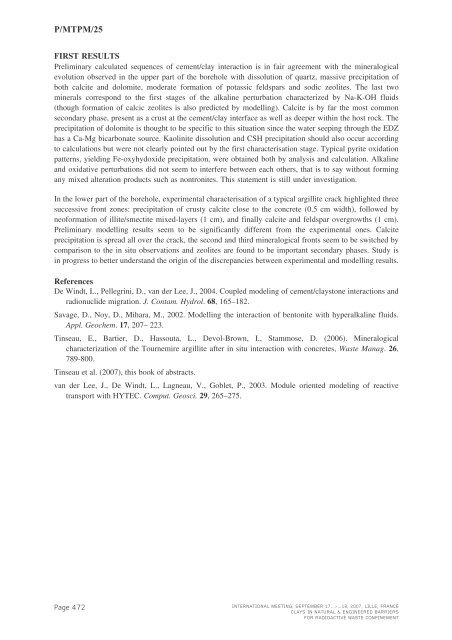Mass Transfer & Porous Media (MTPM) - Andra
Mass Transfer & Porous Media (MTPM) - Andra
Mass Transfer & Porous Media (MTPM) - Andra
Create successful ePaper yourself
Turn your PDF publications into a flip-book with our unique Google optimized e-Paper software.
P/<strong>MTPM</strong>/25FIRST RESULTSPreliminary calculated sequences of cement/clay interaction is in fair agreement with the mineralogicalevolution observed in the upper part of the borehole with dissolution of quartz, massive precipitation ofboth calcite and dolomite, moderate formation of potassic feldspars and sodic zeolites. The last twominerals correspond to the first stages of the alkaline perturbation characterized by Na-K-OH fluids(though formation of calcic zeolites is also predicted by modelling). Calcite is by far the most commonsecondary phase, present as a crust at the cement/clay interface as well as deeper within the host rock. Theprecipitation of dolomite is thought to be specific to this situation since the water seeping through the EDZhas a Ca-Mg bicarbonate source. Kaolinite dissolution and CSH precipitation should also occur accordingto calculations but were not clearly pointed out by the first characterisation stage. Typical pyrite oxidationpatterns, yielding Fe-oxyhydoxide precipitation, were obtained both by analysis and calculation. Alkalineand oxidative perturbations did not seem to interfere between each others, that is to say without formingany mixed alteration products such as nontronites. This statement is still under investigation.In the lower part of the borehole, experimental characterisation of a typical argillite crack highlighted threesuccessive front zones: precipitation of crusty calcite close to the concrete (0.5 cm width), followed byneoformation of illite/smectite mixed-layers (1 cm), and finally calcite and feldspar overgrowths (1 cm).Preliminary modelling results seem to be significantly different from the experimental ones. Calciteprecipitation is spread all over the crack, the second and third mineralogical fronts seem to be switched bycomparison to the in situ observations and zeolites are found to be important secondary phases. Study isin progress to better understand the origin of the discrepancies between experimental and modelling results.ReferencesDe Windt, L., Pellegrini, D., van der Lee, J., 2004. Coupled modeling of cement/claystone interactions andradionuclide migration. J. Contam. Hydrol. 68 , 165–182.Savage, D., Noy, D., Mihara, M., 2002. Modelling the interaction of bentonite with hyperalkaline fluids.Appl. Geochem. 17 , 207– 223.Tinseau, E., Bartier, D., Hassouta, L., Devol-Brown, I., Stammose, D. (2006). Mineralogicalcharacterization of the Tournemire argillite after in situ interaction with concretes, Waste Manag . 26,789-800.Tinseau et al. (2007), this book of abstracts.van der Lee, J., De Windt, L., Lagneau, V., Goblet, P., 2003. Module oriented modeling of reactivetransport with HYTEC. Comput. Geosci. 29 , 265–275.Page 472INTERNATIONAL MEETING, SEPTEMBER 17...>...18, 2007, LILLE, FRANCECLAYS IN NATURAL & ENGINEERED BARRIERSFOR RADIOACTIVE WASTE CONFINEMENT
















